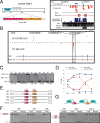Nova2 regulates neuronal migration through an RNA switch in disabled-1 signaling
- PMID: 20620871
- PMCID: PMC2965850
- DOI: 10.1016/j.neuron.2010.05.007
Nova2 regulates neuronal migration through an RNA switch in disabled-1 signaling
Abstract
Neuronal migration leads to a highly organized laminar structure in the mammalian brain, and its misregulation causes lissencephaly and behavioral and cognitive defects. Reelin signaling, which is mediated in part by a key adaptor, disabled-1 (Dab1), plays a critical but incompletely understood role in this process. We found that the neuron-specific RNA-binding protein Nova2 regulates neuronal migration in late-generated cortical and Purkinje neurons. An unbiased HITS-CLIP and exon junction array search for Nova-dependent reelin-pathway RNAs at E14.5 revealed only one candidate-an alternatively spliced isoform of Dab1 (Dab1.7bc). In utero electroporation demonstrated that Dab1.7bc was sufficient to induce neuronal migration defects in wild-type mice and exacerbate defects when Dab1 levels were reduced, whereas Dab1 overexpression mitigates defects in Nova2 null mice. Thus, Nova2 regulates an RNA switch controlling the ability of Dab1 to mediate neuronal responsiveness to reelin signaling and neuronal migration, suggesting new links between splicing regulation, brain disease, and development.
Figures






Comment in
-
Alternative splicing disabled by Nova2.Neuron. 2010 Jun 24;66(6):811-3. doi: 10.1016/j.neuron.2010.06.012. Neuron. 2010. PMID: 20620865
References
-
- Akamatsu W, Okano HJ, Osumi N, Inoue T, Nakamura S, Sakakibara SI, Miura M, Matsuo N, Darnell RB, Okano H. Mammalian ELAV-like neuronal RNA-binding proteins HuB and HuC promote neuronal development in both the central and the peripheral nervous systems. Proc Natl Acad Sci U S A. 1999;96:9885–9890. - PMC - PubMed
-
- Amadio JP, Walsh CA. Brain evolution and uniqueness in the human genome. Cell. 2006;126:1033–1035. - PubMed
-
- Ayala R, Shu T, Tsai LH. Trekking across the brain: the journey of neuronal migration. Cell. 2007;128:29–43. - PubMed
-
- Bar I, Tissir F, Lambert de Rouvroit C, De Backer O, Goffinet AM. The gene encoding disabled-1 (DAB1), the intracellular adaptor of the Reelin pathway, reveals unusual complexity in human and mouse. J Biol Chem. 2003;278:5802–5812. - PubMed
-
- Blencowe BJ, Ahmad S, Lee LJ. Current-generation high-throughput sequencing: deepening insights into mammalian transcriptomes. Genes Dev. 2009;23:1379–1386. - PubMed
Publication types
MeSH terms
Substances
Grants and funding
LinkOut - more resources
Full Text Sources
Molecular Biology Databases

